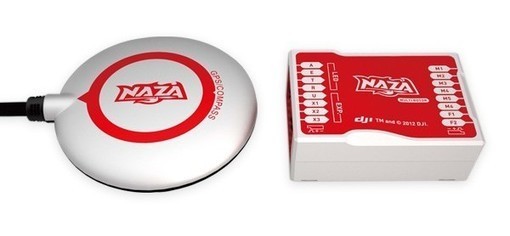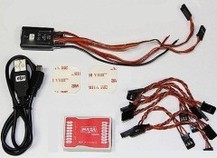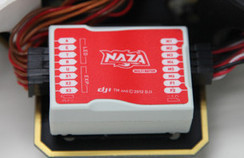DJI NAZA-M Flight Controller
Tuesday 15th January 2013
What is a DJI Naza-M Flight Controller
The DJI Naza-M Flight Controller is a lightweight multi-axis control platform specially designed for multirotor plateforms such a Quadcopters and Hexcopters. It's an all-in-one module that includes the controller, gyroscopes, accelerometers and a barometer as well as a D-Bus support port which can be used to upgrade to the exceptional GPS and Compass module – This is also a must!.
What Does it Do?
The DJI Naza-M Controller simplifies installation, saves space as well as weight, with the innovative All-in-One design the Naza-M controller contains an internal damping system, 3-axis Gyroscope, 3-axis Accelerometer and a barometer. With all these systems working together and using sophisticated algorithms the Naza-M Controller can and will produce a nice stable easily controllable platform and if balanced correctly will even allow some hands off stability in ALLT mode. On top of the above DJI also now offer as an upgrade a GPS and Compass module that allows enhanced performance for the entry aerial photographer or keen hobbyist with position hold, return to home and intelligent orientation control. In position hold the GPS module can offer a precision of 2.5 meters horizontal and 0.8 meters vertically.
Mounting
Mounting the Naza-M Controller to your frame couldn’t be any easier; it’s simply some double sided sticky tape, a few connections to the motors and then another few to your chosen receiver. DJI Innovations supply a very good manual with pictures to help you get through the whole process from start to finish. You will however need to know some basic transmitter programming to get everything set correctly as making sure you have a failsafe set is one of the most important steps, without this you run the risk of having an expensive crash or worse a “fly away”.
Flight Testing
The below testing review is using both the F550 and the TBS Discovery.
Manual Mode - Flying in manual basically means flying to the equivalent of “Rate Mode” on a Tail Gyro where if you were to push the stick forward then the Multirotor will keep going in that direction until corrected by the pilot. Manual mode is surprisingly easy and very responsive, am not sure if this is due to flying 3D helicopter for a few years or the fact that even with only small adjustments to the stock settings it’s dialed in, although with the TBS Discovery there is some pitching up when flying into the wind that could probably be sorted by using a smaller battery than the 4S 4500mah am currently using (Try a 4S 3500mah instead). I wouldn’t recommend flying in the mode thought while doing FPV as it could catch you out if you’re not careful.
ALLT Mode – By far the mode that everyone will use the most if they don’t have the GPS module, it offers auto leveling and increased stability but if you have your camera hard mounted and its other than a perfectly calm day then you will get some wobble feedback even if your gains are really low. This is a great mode if you have a fast, slop free gimbal that has a good range of movement so you’re not hitting the servo end points.
GPS Mode – Offers exactly the same increased stability as the ALLT Mode but also offers Position Hold, Return to Home in the event of signal failure and Intelligent Orientation Control. The two features I personally use are the Return to Home and Position Hold as don’t really need the other features but it’s always nice to have it there if I require. The position hold is very handy for the start and end of the flight as it allows you as the pilot to put your goggles on and off without having to rush as your copter will sit there happy enough until you are ready to fly. The Return to Home function in my opinion is a must! It can be activated manually but if you were to loose signal either through interference or low transmitter battery the multirotor will fly 20 meters up from its current height and fly to the home position which is where you plugged the battery in. You will however need to wait until you have enough satellites available before taking off, the more you have the closer and more accurate it will be.







